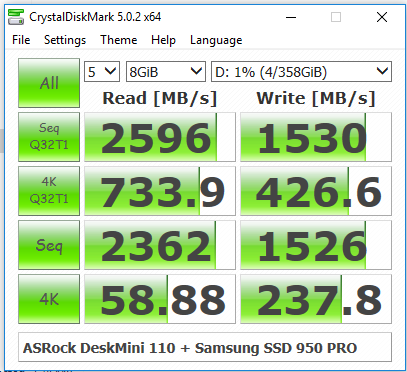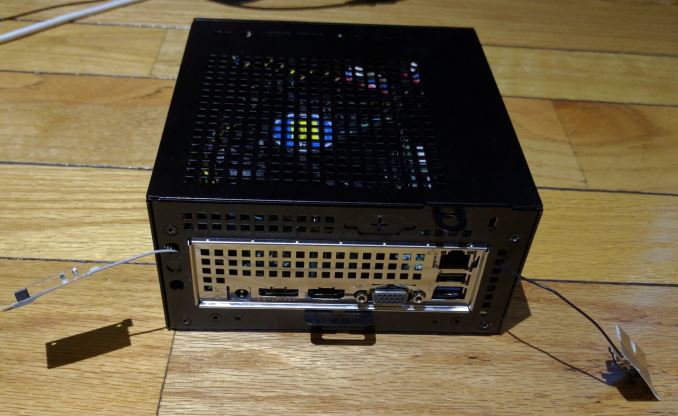ASRock DeskMini 110 mini-STX PC Review
by Ganesh T S on June 8, 2016 8:45 AM ESTNetworking and Storage Performance
Networking and storage are two major aspects which influence our experience with any computing system. This section presents results from our evaluation of these aspects in the ASRock DeskMini 110. On the storage side, one option would be repetition of our strenuous SSD review tests on the drive(s) in the PC. Fortunately, to avoid that overkill, PCMark 8 has a storage bench where certain common workloads such as loading games and document processing are replayed on the target drive. Results are presented in two forms, one being a benchmark number and the other, a bandwidth figure. We ran the PCMark 8 storage bench on selected PCs and the results are presented below.


Despite using the same SSD, we do see some difference in scores between Skull Canyon and the DeskMini. This probably results from differences in the CPU capabilities, since the storage bandwidth actually reflects the amount of time that the CPU was waiting on at least one I/O request to the disk.
The important aspect to test from the DeskMini viewpoint is PCIe 3.0 x4 support (since the H110 has only PCIe 2.0 support). We ran the quick CrystalDiskMark check and could see that the Samsung SSD 950 PRO showed its quoted performance numbers.
On the networking side, we restricted ourselves to the evaluation of the WLAN component. Our standard test router is the Netgear R7000 Nighthawk configured with both 2.4 GHz and 5 GHz networks. The router is placed approximately 20 ft. away, separated by a drywall (as in a typical US building). A wired client is connected to the R7000 and serves as one endpoint for iperf evaluation. The PC under test is made to connect to either the 5 GHz (preferred) or 2.4 GHz SSID and iperf tests are conducted for both TCP and UDP transfers. It is ensured that the PC under test is the only wireless client for the Netgear R7000. We evaluate total throughput for up to 32 simultaneous TCP connections using iperf and present the highest number in the graph below.

In the UDP case, we try to transfer data at the highest rate possible for which we get less than 1% packet loss.

Our main aim with the WLAN component was to show that the DeskMini could indeed support a M.2 PCIe WLAN module. Intel actually provided us with a AC8260 card meant for the Skull Canyon NUC. Therefore, the antenna type we got was really not a good fit for the all-metal chassis. We ended up doing the above evaluation with the antennae not mounted to the chassis, but just hanging out of the system. Despite this unwieldy setup, the system had no trouble getting good numbers in our bandwidth test.
The DeskMini chassis does provide three perforations diagonally across the M.2 WLAN slot in the rear to install screw-type antennas. Consumers can keep this in mind while hunting for the appropriate WLAN component to complete a DeskMini build.












85 Comments
View All Comments
Lukart - Wednesday, June 8, 2016 - link
That pricing looks really good! Now I want to see this thing listed..JoeyJoJo123 - Wednesday, June 8, 2016 - link
Might have been interesting and possibly worth a buy if it included 2 Intel Ethernet ports, to act as a pfSense box. I guess I'll pass.A5 - Wednesday, June 8, 2016 - link
You don't need a 65W CPU to do pfSense.Shadowmaster625 - Wednesday, June 8, 2016 - link
$739? For that money you can buy a i5-6300HQ notebook that comes with a 960M. Even if you dont use the screen, you still get to make use of the built-in UPS of the notebook.ganeshts - Wednesday, June 8, 2016 - link
The $739 is due to our choice of components - the Core i5 is $204, the SSD is $317, the RAM is $57 and so on.. people can budget for these components differently (using a SATA 2.5" drive could bring down that price by $250).t.s - Wednesday, June 8, 2016 - link
And where is the sata port?nightbringer57 - Wednesday, June 8, 2016 - link
Looks like there are two mounting slots under the mainboard.There doesn't seem to be a standard SATA connector, but there is a connector marked "SATA 3" (on the edge of the board, between the back USB connectors and the "chipset"). I'm assuming this is some form of non-conventional SATA port that combines data and power lines as there is no traditional PSU, but the converters must be on the motherboard, and enables to use a proprietary cable to connect the drivers.
nightbringer57 - Wednesday, June 8, 2016 - link
(addendum)If you look at the bundle photo, you can see the weird-SATAoid-thingy-to-standard-SATA-adapter in the small plastic bag.
The_Assimilator - Wednesday, June 8, 2016 - link
Well spotted, for a while I thought ASRock had given us a pair of 2.5" mounts with no way to use them...zodiacfml - Wednesday, June 8, 2016 - link
Right. I did a quick math and the price of this mini is reasonable. In my opinion, this is the only mini that I found with a decent price as most small PCs reviewed here are not cost competitive to a laptop.The price also reflects the simple quality of the case but who cares. The niche of this product is the decent price.